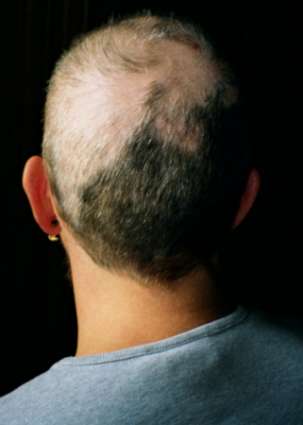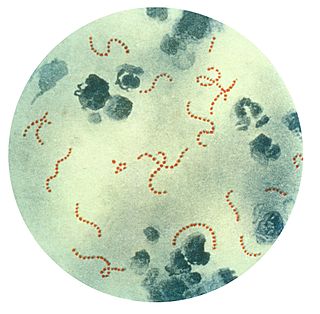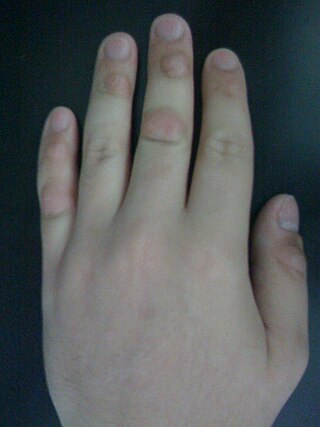
Tourette syndrome or Tourette's syndrome is a common neurodevelopmental disorder that begins in childhood or adolescence. It is characterized by multiple movement (motor) tics and at least one vocal (phonic) tic. Common tics are blinking, coughing, throat clearing, sniffing, and facial movements. These are typically preceded by an unwanted urge or sensation in the affected muscles known as a premonitory urge, can sometimes be suppressed temporarily, and characteristically change in location, strength, and frequency. Tourette's is at the more severe end of a spectrum of tic disorders. The tics often go unnoticed by casual observers.

Trichotillomania (TTM), also known as hair-pulling disorder or compulsive hair pulling, is a mental disorder characterized by a long-term urge that results in the pulling out of one's own hair. A brief positive feeling may occur as hair is removed. Efforts to stop pulling hair typically fail. Hair removal may occur anywhere; however, the head and around the eyes are most common. The hair pulling is to such a degree that it results in distress and hair loss can be seen.
Coprolalia is involuntary swearing or the involuntary utterance of obscene words or socially inappropriate and derogatory remarks. The word comes from the Greek κόπρος, meaning "dung, feces", and λαλιά "speech", from λαλεῖν "to talk".

A tic is a sudden and repetitive motor movement or vocalization that is not rhythmic and involves discrete muscle groups. It is typically brief, and may resemble a normal behavioral characteristic or gesture.
The Jumping Frenchmen of Maine were a group of 19th-century lumberjacks who exhibited a rare disorder of unknown origin. The syndrome entails an exaggerated startle reflex which may be described as an uncontrollable "jump"; individuals with this condition can exhibit sudden movements in all parts of the body. Jumping Frenchmen syndrome shares some symptoms with other startle disorders.

Nail biting, also known as onychophagy or onychophagia, is an oral compulsive habit of biting one's fingernails. It is sometimes described as a parafunctional activity, the common use of the mouth for an activity other than speaking, eating, or drinking.

Excoriation disorder, more commonly known as dermatillomania, is a mental disorder on the obsessive–compulsive spectrum that is characterized by the repeated urge or impulse to pick at one's own skin, to the extent that either psychological or physical damage is caused.

Pediatric autoimmune neuropsychiatric disorders associated with streptococcal infections (PANDAS) is a controversial hypothetical diagnosis for a subset of children with rapid onset of obsessive-compulsive disorder (OCD) or tic disorders. Symptoms are proposed to be caused by group A streptococcal (GAS), and more specifically, group A beta-hemolytic streptococcal (GABHS) infections. OCD and tic disorders are hypothesized to arise in a subset of children as a result of a post-streptococcal autoimmune process. The proposed link between infection and these disorders is that an autoimmune reaction to infection produces antibodies that interfere with basal ganglia function, causing symptom exacerbations, and this autoimmune response results in a broad range of neuropsychiatric symptoms.

Tic disorders are defined in the Diagnostic and Statistical Manual of Mental Disorders (DSM) based on type and duration of tics. Tic disorders are defined similarly by the World Health Organization.
Stereotypic movement disorder (SMD) is a motor disorder with onset in childhood involving restrictive and/or repetitive, nonfunctional motor behavior, that markedly interferes with normal activities or results in bodily injury. To be classified as SMD, the behavior in question must not be due to the direct effects of a substance, autism, or another medical condition. The cause of this disorder is not known.
Tourette syndrome is an inherited neurodevelopmental disorder that begins in childhood or adolescence, characterized by the presence of motor and phonic tics. The management of Tourette syndrome has the goal of managing symptoms to achieve optimum functioning, rather than eliminating symptoms; not all persons with Tourette's require treatment, and there is no cure or universally effective medication. Explanation and reassurance alone are often sufficient treatment; education is an important part of any treatment plan.
Causes and origins of Tourette syndrome have not been fully elucidated. Tourette syndrome is an inherited neurodevelopmental disorder that begins in childhood or adolescence, characterized by the presence of multiple motor tics and at least one phonic tic, which characteristically wax and wane. Tourette's syndrome occurs along a spectrum of tic disorders, which includes transient tics and chronic tics.
Sensory phenomena are general feelings, urges or bodily sensations. They are present in many conditions including autism spectrum disorders, epilepsy, neuropathy, obsessive–compulsive disorder, pain conditions, tardive syndromes, and tic disorders.
The obsessive–compulsive spectrum is a model of medical classification where various psychiatric, neurological and/or medical conditions are described as existing on a spectrum of conditions related to obsessive–compulsive disorder (OCD). "The disorders are thought to lie on a spectrum from impulsive to compulsive where impulsivity is said to persist due to deficits in the ability to inhibit repetitive behavior with known negative consequences, while compulsivity persists as a consequence of deficits in recognizing completion of tasks." OCD is a mental disorder characterized by obsessions and/or compulsions. An obsession is defined as "a recurring thought, image, or urge that the individual cannot control". Compulsion can be described as a "ritualistic behavior that the person feels compelled to perform". The model suggests that many conditions overlap with OCD in symptomatic profile, demographics, family history, neurobiology, comorbidity, clinical course and response to various pharmacotherapies. Conditions described as being on the spectrum are sometimes referred to as obsessive–compulsive spectrum disorders.

Tourette syndrome is an inherited neurological disorder that begins in childhood or adolescence, characterized by the presence of multiple physical (motor) tics and at least one vocal (phonic) tic.
Massed negative practice is a proposed treatment for the tics of Tourette syndrome in which the individual with Tourette's "practices" tics continuously until a conditioned level of fatigue is reached. It is based upon the Hullian learning theory, which holds that tics are "maladaptive habits that are strengthened by repetition and can be replaced by the strengthening of more adaptive habits ". There is little evidence supporting its efficacy in the treatment of tics.

Body-focused repetitive behavior (BFRB) is an umbrella name for impulse control behaviors involving compulsively damaging one's physical appearance or causing physical injury.
Nathan H. Azrin was a behavioral modification researcher, psychologist, and university professor. He taught at Southern Illinois University and was the research director of Anna State Hospital between 1958 and 1980. In 1980 he became a professor at Nova Southeastern University, and entered emeritus status at the university in 2010. Azrin was the founder of several research methodologies, including Token Economics, the Community Reinforcement Approach (CRA) on which the CRAFT model was based, Family Behavior Therapy, and habit reversal training. According to fellow psychologist Brian Iwata “Few people have made research contributions equaling Nate’s in either basic or applied behaviour analysis, and none have matched his contributions to both endeavors.”
Decoupling is a behavioral self-help intervention for body-focused and related behaviors (DSM-5) such as trichotillomania, onychophagia, skin picking and lip-cheek biting. The user is instructed to modify the original dysfunctional behavioral path by performing a counter-movement shortly before completing the self-injurious behavior. This is intended to trigger an irritation, which enables the person to detect and stop the compulsive behavior at an early stage. A systematic review from 2012 suggested some efficacy of decoupling, which was corroborated by Lee et al. in 2019. Whether or not the technique is superior to other behavioral interventions such as habit reversal training awaits to be tested. Decoupling is a variant of habit reversal training.
A premonitory urge is a sensory phenomenon associated with Tourette syndrome and other tic disorders. Premonitory urges are "uncomfortable feelings or sensations preceding tics that usually are relieved by [a particular] movement".